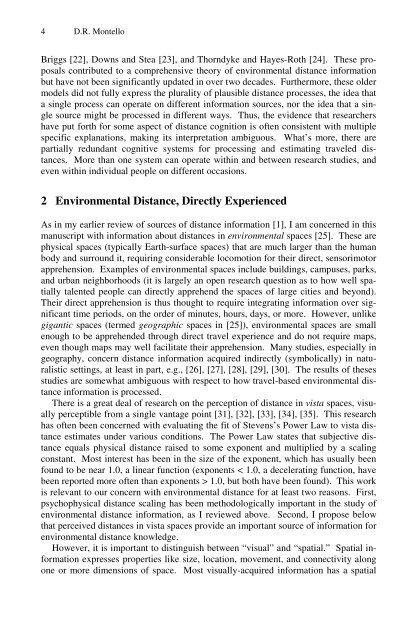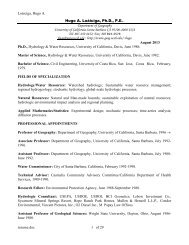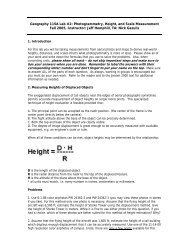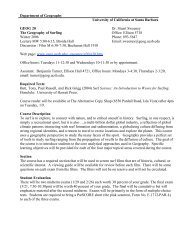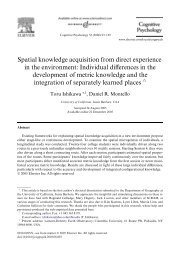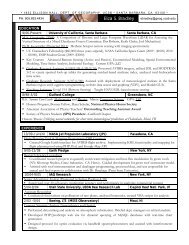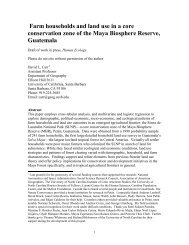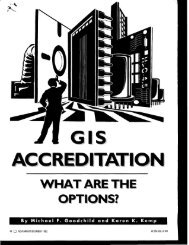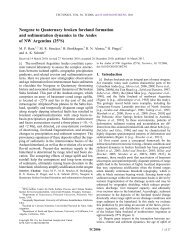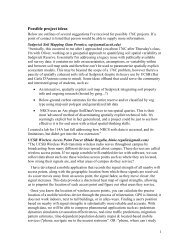A Conceptual Model of the Cognitive Processing of Environmental ...
A Conceptual Model of the Cognitive Processing of Environmental ...
A Conceptual Model of the Cognitive Processing of Environmental ...
You also want an ePaper? Increase the reach of your titles
YUMPU automatically turns print PDFs into web optimized ePapers that Google loves.
4 D.R. Montello<br />
Briggs [22], Downs and Stea [23], and Thorndyke and Hayes-Roth [24]. These proposals<br />
contributed to a comprehensive <strong>the</strong>ory <strong>of</strong> environmental distance information<br />
but have not been significantly updated in over two decades. Fur<strong>the</strong>rmore, <strong>the</strong>se older<br />
models did not fully express <strong>the</strong> plurality <strong>of</strong> plausible distance processes, <strong>the</strong> idea that<br />
a single process can operate on different information sources, nor <strong>the</strong> idea that a single<br />
source might be processed in different ways. Thus, <strong>the</strong> evidence that researchers<br />
have put forth for some aspect <strong>of</strong> distance cognition is <strong>of</strong>ten consistent with multiple<br />
specific explanations, making its interpretation ambiguous. What’s more, <strong>the</strong>re are<br />
partially redundant cognitive systems for processing and estimating traveled distances.<br />
More than one system can operate within and between research studies, and<br />
even within individual people on different occasions.<br />
2 <strong>Environmental</strong> Distance, Directly Experienced<br />
As in my earlier review <strong>of</strong> sources <strong>of</strong> distance information [1], I am concerned in this<br />
manuscript with information about distances in environmental spaces [25]. These are<br />
physical spaces (typically Earth-surface spaces) that are much larger than <strong>the</strong> human<br />
body and surround it, requiring considerable locomotion for <strong>the</strong>ir direct, sensorimotor<br />
apprehension. Examples <strong>of</strong> environmental spaces include buildings, campuses, parks,<br />
and urban neighborhoods (it is largely an open research question as to how well spatially<br />
talented people can directly apprehend <strong>the</strong> spaces <strong>of</strong> large cities and beyond).<br />
Their direct apprehension is thus thought to require integrating information over significant<br />
time periods, on <strong>the</strong> order <strong>of</strong> minutes, hours, days, or more. However, unlike<br />
gigantic spaces (termed geographic spaces in [25]), environmental spaces are small<br />
enough to be apprehended through direct travel experience and do not require maps,<br />
even though maps may well facilitate <strong>the</strong>ir apprehension. Many studies, especially in<br />
geography, concern distance information acquired indirectly (symbolically) in naturalistic<br />
settings, at least in part, e.g., [26], [27], [28], [29], [30]. The results <strong>of</strong> <strong>the</strong>ses<br />
studies are somewhat ambiguous with respect to how travel-based environmental distance<br />
information is processed.<br />
There is a great deal <strong>of</strong> research on <strong>the</strong> perception <strong>of</strong> distance in vista spaces, visually<br />
perceptible from a single vantage point [31], [32], [33], [34], [35]. This research<br />
has <strong>of</strong>ten been concerned with evaluating <strong>the</strong> fit <strong>of</strong> Stevens’s Power Law to vista distance<br />
estimates under various conditions. The Power Law states that subjective distance<br />
equals physical distance raised to some exponent and multiplied by a scaling<br />
constant. Most interest has been in <strong>the</strong> size <strong>of</strong> <strong>the</strong> exponent, which has usually been<br />
found to be near 1.0, a linear function (exponents < 1.0, a decelerating function, have<br />
been reported more <strong>of</strong>ten than exponents > 1.0, but both have been found). This work<br />
is relevant to our concern with environmental distance for at least two reasons. First,<br />
psychophysical distance scaling has been methodologically important in <strong>the</strong> study <strong>of</strong><br />
environmental distance information, as I reviewed above. Second, I propose below<br />
that perceived distances in vista spaces provide an important source <strong>of</strong> information for<br />
environmental distance knowledge.<br />
However, it is important to distinguish between “visual” and “spatial.” Spatial information<br />
expresses properties like size, location, movement, and connectivity along<br />
one or more dimensions <strong>of</strong> space. Most visually-acquired information has a spatial


